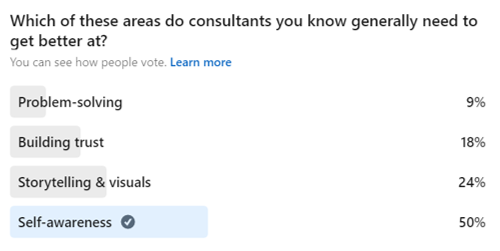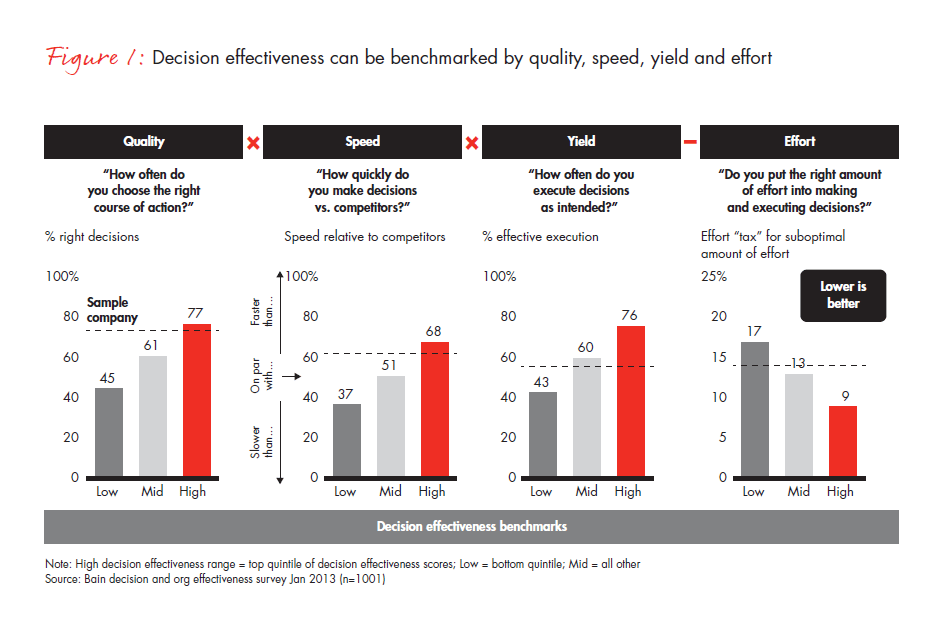🐝 Consulting Skills Mastery Issue 1 - If you spot it, you've got it 🔮

Welcome to this first edition of Consulting Skills Mastery! Keep it in pristine condition, it might be worth millions as an NFT in a few years...
❔What to expect from me?
My aim with this newsletter is to share my experiences, best practices, and practical guidance for developing consulting skills. I've been a consultant since 2005 and have worked in & with many different firms - from 6 years at Bain & Company, through to advising lots of high-growth boutiques.
These days I specialise in helping consulting firms manage & develop their people in ways that accelerate development & fast-track growth.
I'm also building a new kind of advisory & training business. Calm by design, decentralised and transparent. I'll share some of that journey too.
In this edition
1. Self-aware Consultant: If you spot it, you've got it
2. Problem Solver: Think like another
3. Trusted Advisor: Active listening
4. Communicator: Getting good decisions
5. The week in consulting

If you spot it, you've got it
I recently asked my connections on LinkedIn what skill they thought most consultants needed to get better at. The answer was surprising.
50% said Self-Awareness.

Self-awareness is a big thing for me. I've done a lot of personal work in this area over the last few years and it's had dramatic impact in my consulting work too.
That is a big part of the reason why I'm re-launching my course The Resilient Consultant (see this post for more on why & how I'm doing that).
So, how to build self-awareness? Here's one practical tip, in the form of a simple phrase: "If you spot it, you've got it".
I was working with a founder-led data analytics boutique a couple of years ago. The founder was a dominant personality in the business, and sadly lacking in self-awareness.
When he arrived in the office I'd see him stomp in, distracted, not acknowledge anyone and sit down at his desk looking stressed & angry.
One day we had a catch-up shortly after he'd come in. He was frustrated with one of his Managers, complaining that "He needs to change his attitude. Every day he comes in stressed, distracted, doesn't talk to the team and just heads straight to his desk"
It was remarkable to hear this, from someone who behaved in exactly that way himself!
"If you spot it, you've got it" is a well-known concept from coaching & therapy. The way I use it is simple:
Often that uncovers things I do, that I find irritating when I experience other people doing them.
Why do I feel irritated at other people doing things that I also do myself? Isn't that counter-intuitive, even hypocritical?
The irritation arises as an unconscious signal that I behave in ways that aren't aligned with my values. The negative emotion is indicator of something I'm not consciously aware of.
Ultimately, the irritation I feel in that moment is a gift.
Once I'm aware that I do these things I can take steps to change my own behaviours. To act more in line with my values.
Have you been irritated by the behaviour of a client or a colleague recently? What might that tell you about some way that you behave yourself?
Want more on this? I recommended the book The 15 Commitments of Conscious Leadership by Jim Dethmer, Diana Chapman, and Kaley Warner Klemp

Think Like Another
Problem-solving is a foundational skill for all consultants. It's the way we get things done, often a primary reason clients bring us in the first place.
There are many different approaches to this, suitable for different situations. The classic is structured hypothesis-led problem-solving, using the approaches Barbara Minto first defined in The Pyramid Principle.
IMO, an over-looked aspect of problem-solving is coming up with creative solutions.
One way I mix this up is by implementing the tools Ian Atkinson lays out in his simple & practical book The Creative Problem Solver. We practice using these in our High Impact Delivery course for experienced consultants as well.
Of the tools in the book my personal favourite is 'Think Like Another'. This involves getting into character, shifting your mindset away from the obvious to bring different perspectives to the problem.
For example, I helped an estate agency business develop their 5 year strategic plan. There were several options we were considering, including how best to build reputation with their tenants.
Classically, you might look at tenant feedback, develop personas, or run some focus groups to get under the skin of what tenants cared about.
We wanted to go a step further to unlock some bigger ideas.
Having articulated what we thought was a powerful approach for tenants, we had the team get into character. One was a single mother with two young kids. Two were young flat-sharers. We even had one playing a seven year old boy - I brought comics and crayons to help him get into character.
With those new identities, we took them through what we were thinking and had them react and ask questions in character. This had two major benefits.
Firstly, we got some new ideas and perspectives. The seven year old boy looked at the world in quite simple terms, and we realised how stressful moving to a new home can be for a kid who doesn't realise his toys are coming with him. And any parent knows that stressed kids lead to stressed parents, at an already difficult time.
Secondly, the team individually had lightbulb moments about some of their unconscious beliefs that were limiting their thinking. Tenants were previously not truly treated as customers, because my client's revenue came from landlords. But realising that tenants had a major influence on reputation, and many were planning to become home-owners soon, changed how they were seen.
When we came back into the 'real world', the conversation had shifted gears into a materially more creative, transformational set of ideas.
How can you Think Like Another on your current project? What limiting beliefs can that new character help you see differently?
Want more on this? I recommended the book The Creative Problem Solver by Ian Atkinson.

Active Listening
As a consultant you need your clients to trust you, and trust your recommendations.
After all if they don't trust you they won't have the confidence to do anything differently. And if nothing changes after your project... you've pretty much wasted a lot of time, effort and money for everyone involved.
Getting people to take action is at the heart of consulting.
For this reason we spend a lot of time in our courses discussing The Trust Equation, as articulated by David Maister. It states that how much someone trusts you is a function of your credibility, reliability, emotional intimacy, and low self-orientation.
Here's the slide we use to introduce it:

One of the most powerful ways to use this to build trust is a combination of Active Listening and High Gain Questions. I'm going to talk about Active Listening today and cover High Gain Questions next time.
You've probably heard of Active Listening. The term gets thrown around a lot. Here's how I think about it.
I struggle to think of these things in the abstract so I always like to bring it back to practical steps. So here's how I implement Active Listening: Listen, Observe, Verify, Empathise
Yes, that spells LOVE. It might seem strange to talk about love in the context of a consulting engagement. But remember that if you want to build trust you need to show emotional intimacy and low levels of self-orientation.
Let's break it down.
- Listen: Sounds simple, but is hard in practice. You have to actually listen to the words they are saying. Stop yourself when you start thinking about your clever response or your next question - there will be time for that later.
- Observe: Look beyond their words to their body-language and non-verbal queues. Do they seem comfortable? Emotional? Confused? Try to identify what might be going on for them.
- Verify: This is key. Check that you have heard and understood what they have said. I like to do this using exactly the words they used. That forces me to listen hard - I want to remember the words - and leaves no doubt that they have been heard. "I want to be sure I've understood you correctly. What I heard you say was that we need to be careful with how we present these data at the SteerCo because your CFO is likely to react badly. You'd like us to pre-wire her beforehand and make sure she understands the assumptions we've made."
- Empathise: This is the point where you can take a risk in the name of building emotional connection. Say what you observed in them, and see if it resonates. "I can see you have some concerns about where the project is heading - is that making you worried?"
The over-arching mindset to really make this work effectively is simple: Be Curious.
If you are genuinely curious about the person in front of you, what they are saying and how they are feeling, this will come naturally. The challenge is to park your own needs for a few minutes so you can focus on them. That can be really difficult in the middle of an intense consulting engagement.
Parking your own needs is the essence of low self-orientation, a key factor in the Trust Equation. Using these practical steps to implement active listening can help you become a Trusted Advisor.
When are you next talking to a client? Are you ready to really listen to them?
Want more on this? I recommended the book The Trusted Advisor by David Maister.

Getting Good Decisions
Very often, as a consultant, your job is to help someone make a decision.
These can be big decisions like "should we buy this company?" or "how much cost do we need to cut?". Just as important are the apparently smaller decisions - like frontline workers having to decide "will I do what they are asking me to do?".
I focus a lot on decisions as the necessary door to action. To be effective in communicating with your audience you need to take them on a journey. First, they must pay attention. Then understand, and remember. And finally, if you've convinced them to, they'll decide to take action.
It's like being at a fairground and testing your strength. How strong is your message?

To get them on the journey to that all important decision takes a few different things. I group them in 4 buckets:
- Access to relevant information & expertise
- An appropriate framework for decision-making
- The decision-making environment
- Confidence
Of course, you can make bad decisions with just Confidence, but the other three are important if you want your clients to make good decisions. Which I assume you do!
As an aside, how do you define a good decision? Bain & Company's research on this shows 4 dimensions for effective decision-making processes: Quality, Speed, Effort, and Ability to Execute (which they call Yield).

If you want to help your clients make better decisions I wrote a detailed post on exactly how do set up meetings to help them - read it here - or check out our High Impact Delivery course for experienced consultants. We discuss this in detail there, and practice designing effective meetings.
Want more on this? I recommended the book Decide & Deliver by Marcia Blenko, Michael Mankins and Paul Rogers.

Best new thinking this week
The Economist wrote a lightweight piece knocking consulting. Friend of Honeycomb PS, Prof Joe O'Mahoney pointed out some gaps in it...
Source published their latest research into what matters to the buyers of consulting services - with some dramatic changes vs the recent trend
James O'Sullivan - CEO of the impressively calm consulting firm Project One - on how they manage internal planning in their boutique firm
Nick Synnott interviews the co-CEOs of Yonder Consulting in his latest episode of the Climb in Consulting podcast, uncovering the good & bad of jointly running a boutique firm
Thanks for reading! When you're ready there are three ways I can help you:
1. Consulting Skills training courses (9.2/10 average from 300+ ratings)
2. Our Consulting Skill Accelerator toolkit - get in touch to learn more
3. My free 'Train the Trainer' practical workshop (limited to 12 people each time)
If you'd like to discuss training needs for your consulting team then feel free to book a no obligation call with me here, I'd love to help
I write things like this to help consultants. Subscribe below to get the new stuff straight to your inbox.
